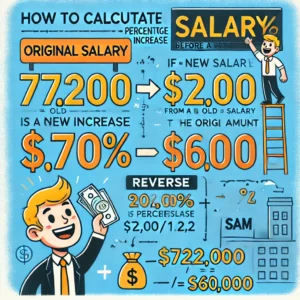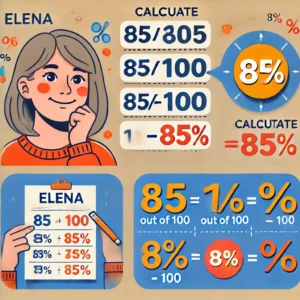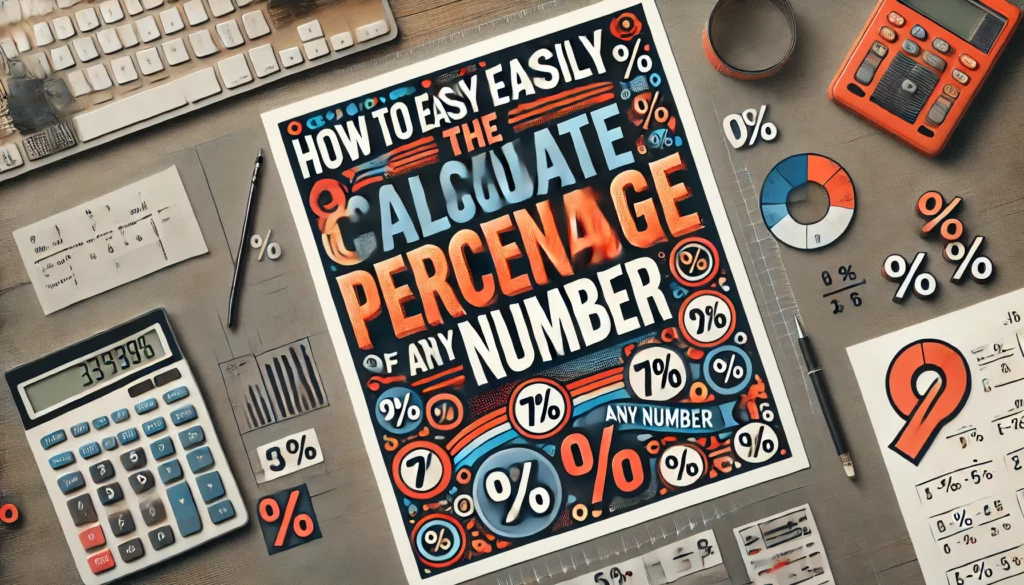Percentages are a part of everyday life. Whether you’re shopping, calculating tips at a restaurant, or figuring out your exam grade, knowing how to calculate percentages is a useful skill. In this guide, we’ll explain how to calculate the percentage of a number, with simple examples to help you understand each step.
What is a Percentage?
Before we get into how to calculate percentages, let’s first understand what a percentage is.
A percentage represents a number as a fraction of 100 and is written using the “%” symbol. For example, “50%” means 50 out of every 100 parts. Percentages are helpful for comparing numbers and understanding proportions.
Here are a few examples:
- 50% means 50 out of 100, or half.
- 25% means 25 out of 100, or a quarter.
- 75% means 75 out of 100, or three-quarters.
How to Calculate the Percentages of a Number: Quick Guide
The formula to calculate the percentage of a number is simple:

- Part: The portion of the number you want to find the percentage of.
- Whole: The total or original amount that the part is a percentage of.
To make this clearer, let’s go through a few practical examples using our characters Sam and Elena.
Example 1: Sam’s Discount on a Jacket

Sam is shopping for a jacket that originally costs $80. The store is offering a 25% discount. Sam wants to know how much the discount will be and what he will pay after the discount.
Step 1: Understand the components.
- Whole: The original price of the jacket, which is $80.
- Percentage: 25% (this is the discount).
Step 2: Use the formula to calculate the discount.
The discount is $20.
Step 3: Subtract the discount from the original price.
The final price is $60.
Example 2: Elena’s Tip Calculation at a Restaurant

Elena is dining out at a restaurant with friends. The total bill comes to $120, and she wants to leave a 15% tip for the waiter. Elena wants to know how much the tip will be.
Step 1: Understand the components.
- Whole: The total bill, which is $120.
- Percentage: 15% (the tip Elena wants to leave).
Step 2: Use the formula to calculate the tip.
The tip is $18.
Step 3: Calculate the total amount to pay.
The total amount is $138.
Understanding Reverse Percentage Calculations
Sometimes, you might be given a part and the percentage, but you need to find the whole. This is the reverse of the calculation we just did. Here’s the formula to reverse the process:

Let’s see how this works with a new example.
Example 3: Sam’s Salary Raise

Sam just got a raise at work. His new salary is $72,000, and he knows this is after a 20% increase from his old salary. Sam wants to figure out how much his old salary was before the raise.
Step 1: Understand the components.
- Part: Sam’s new salary, which is $72,000.
- Percentage: 20% (the raise percentage).
Step 2: Use the reverse formula to find the original salary.
Sam’s old salary was $60,000.
Example 4: Elena’s Percentage of a Grade

Elena has completed her exams, and she wants to calculate what percentage she scored. She got 85 out of a possible 100 points on the test, and she wants to know what percentage that is.
Step 1: Understand the components.
- Part: The points Elena scored, which is 85.
- Whole: The total points possible, which is 100.
Step 2: Use the formula to calculate the percentage.
Elena scored 85% on her exam.
More Complex Percentage Calculations
Now that we’ve covered the basics, let’s dive into a couple of more advanced scenarios where you might need to calculate percentages in different contexts.
Example 5: Sam’s Investment Growth

Sam invests $5,000 in a savings account that offers a 5% annual interest rate. After one year, Sam wants to know how much interest he has earned on his investment.
Step 1: Understand the components.
- Whole: The initial investment amount, which is $5,000.
- Percentage: The annual interest rate, which is 5%.
Step 2: Use the formula to calculate the interest earned.
Sam earned $250 in interest after one year.
Example 6: Elena’s Sales Commission

Elena works as a salesperson, and she earns a 10% commission on every sale. If she makes a sale worth $2,000, how much commission will she earn?
Step 1: Understand the components.
- Whole: The sale amount, which is $2,000.
- Percentage: The commission rate, which is 10%.
Step 2: Use the formula to calculate the commission.
Elena will earn a $200 commission on this sale.
Tips for Easier Percentage Calculations
Here are some tips to help you calculate percentages more quickly:
- Use a Calculator: For larger numbers, a calculator can save you time and make the process easier.
- Estimate: For a quick estimate, round the percentage to a simpler number (e.g., 50% or 25%) to get a rough idea of the amount.
- Break It Down: For more complex percentages, break them into smaller, easier parts. For example, to calculate 15%, first find 10%, then 5%, and add them together.
Conclusion
Knowing how to calculate percentages is a valuable skill that can be used in many aspects of life, from shopping and budgeting to work and school. Whether you’re calculating a discount like Sam or figuring out a tip like Elena, the process is simple once you understand the basic formula.
By practicing with real-life examples, you’ll gain confidence and become faster at calculating percentages. The next time you encounter a percentage problem, you’ll know exactly how to tackle it.
Remember, percentages are a powerful tool for understanding numbers, relationships, and proportions, both in everyday situations and in business.

